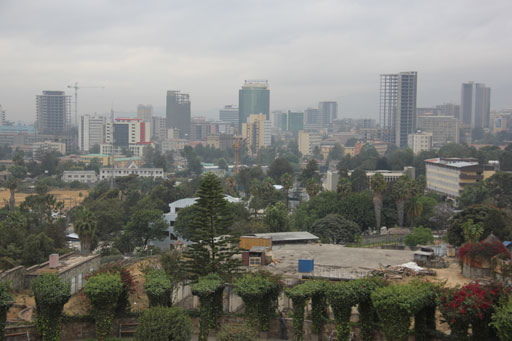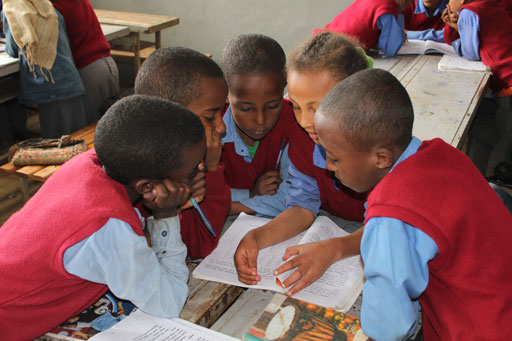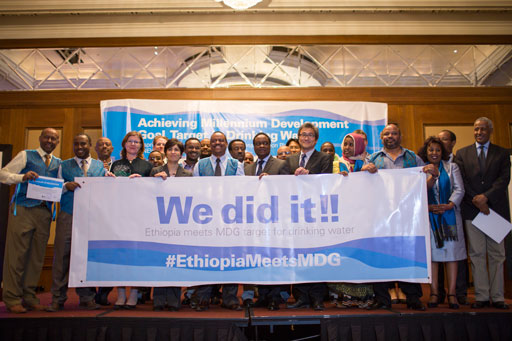3.1 Economic growth, economic development and human development
You may have noticed that a lot of building work for new roads, schools and hospitals is taking place in Ethiopia (Figure 3.1). All these are the result of economic growth in the country, especially since the year 2000. You may think economic growth and economic development are the same thing and use the terms interchangeably, but they are not exactly the same.

The economic growth of a country is an increase in worth of the national economy and is measured by its Gross Domestic Product (GDP). GDP is a measure of the total value of goods and services produced by a country in a year. It is usually measured in US dollars.
Economic development is a broader concept than economic growth that also includes aspects of human welfare. It is linked to technological and social progress, and general improvements in living standards. Economic development means improvements to infrastructure such as roads, schools, water and wastewater treatment plants, hydropower, etc. One of the indicators of economic development is GDP per capita. GDP per capita is the total GDP value divided by the population of the country, giving an indication of the economic output per head of population. This reflects an increase in the economic productivity and average material well-being of a country’s population but does not take account of uneven distribution of wealth among the population.
The GDP of India (US$2.05 trillion) is greater than the GDP of Norway (US$0.5 trillion) (IMF, 2015). So, can we say that India is more economically developed than Norway?
No. India has a higher total GDP than Norway, but it also has a much larger population. So, if you divide the GDP by the population to give GDP per capita, you would see that Norway has a much higher per capita GDP (US$97,013) than India (US$1,626). In reality, therefore, Norway is more economically developed than India.
GDP is a purely economic measure. Economic growth does not necessarily lead to human development. This is because a country can have an increase in GDP without improving the quality of life of the majority of people. Human developmentis the continuous improvement of human well-being and the quality of life. Some of the characteristics associated with countries that are not highly developed are a low literacy rate, high poverty level, high unemployment rate, high malnutrition, low water supply coverage, low health service coverage, poor roads, poor public transport and poor environmental conditions.
The most widely used indicator for human development is the Human Development Index (HDI), which measures the relative development status of different countries on a scale from 0 to 1. It looks beyond economic assessment and brings in other ways of measuring well-being. HDI is a composite index that focuses on three criteria:
- life expectancy
- education
- standard of living.
The first criterion, life expectancy, is the average number of years that a person may expect to live. If people live long and healthy lives, this will increase the HDI of a country. Ethiopia is one of the top six countries where life expectancy has increased the most in recent times, from 45 years in 1990 to 64 years in 2012 (WHO, 2014). This can be attributed to many factors such as better health services, increased safe water supplies and improved access to sanitation.
The second criterion in the HDI, education, comprises two components: years of schooling for the adult population, which is the average number of years of education received in a lifetime by people aged 25 years and older; and the expected years of schooling for children of school-entrance age.Developed countries are expected to have people in education for longer. Average years of education of adults in Ethiopia increased from 1.5 in 2000 to 2.2 in 2012, and expected years of schooling for children increased from 4.4 to 8.7 years over the same period (UNDP, 2013). This is because, since 1994, many schools have been built, teachers have been trained and emphasis has been placed on creating a child-friendly teaching and learning environment in schools (Figure 3.2). Alternative ways of providing basic education for children in remote areas have also been established, such as making the time of learning flexible (e.g. by letting the community decide the time of learning) and establishing mobile schools to reach disadvantaged groups and remote rural areas.

The final criterion in the HDI is standard of living, which means the level of wealth, comfort and material goods available to people. Ethiopia’s standard of living increased by more than 100% between 1985 and 2012 (UNDP, 2013). Despite this achievement, Ethiopia’s standard of living remains one of the lowest in the world.
The Human Development Index for Ethiopia is low. The value for 2012 was 0.396 which puts it in the category of ‘low human development’. The country is ranked 173rd out of 187 countries (UNDP, 2013). However, the situation has been improving as Ethiopia’s HDI increased by 32% in the 10 years to 2012 (UNDP, 2012) and an annual rate of increase of 3.1% places Ethiopia as the country with the third-fastest improving HDI in the world (MoFED, 2012a).
Ethiopia’s development progress can be seen by improvements in a range of areas:
- The poverty level in Ethiopia (defined as the percentage of the population below the national poverty line) declined from 38.7% in 2005 to 29.6% in 2012 (MoFED, 2006, 2012b).
- The adult literacy rate (defined as the percentage of the population age 15 and above who can, with understanding, read and write a short, simple statement on their everyday life) increased from 27% in 1994 to 36% in 2010/2011.
- Access to health facilities increased from 38% in 1991 to 89.6% in 2010 (Banteyerga et al., 2011).
- The total federal road network expanded more than threefold between 1997 and 2013, by which time it included 11,301 km of asphalt and 14,455 km of gravel road (Ethiopian Roads Authority, 2013).
Ethiopia is on track to achieve most of the Millennium Development Goals (MDGs). The MDGs are international development goals that were established following the Millennium Summit of the United Nations in 2000. UN Member States committed to achieve the MDGs by 2015. The goals were grouped into eight areas:
- Eradicate extreme poverty and hunger.
- Achieve universal primary education.
- Promote gender equality and empower women.
- Reduce child mortality.
- Improve maternal health.
- Combat HIV/AIDS, malaria and other diseases.
- Ensure environmental sustainability.
- Develop a global partnership for development.
Each of these goals had more specific targets associated with them. For example, Goal 7 had four targets, including one for improvements to water and sanitation. Target 7C was to ‘halve, by 2015, the proportion of the population without sustainable access to safe drinking water and basic sanitation’.
The 2014 report on MDG progress stated that Ethiopia was on track to achieve six out of the eight goals, i.e. all those except Goals 3 and 5 (NPC, 2015). For Goal 7, the picture is a little more complicated. Ethiopia successfully achieved the target for water supply but not for improvements to sanitation. Water supply coverage has increased and in March 2015 Ethiopia celebrated achieving the target of halving the number of people who were without access to safe water (Figure 3.3). Sanitation coverage has greatly improved, but with 37% of the population still using open defecation in 2012 (JMP, 2014) it has fallen short of the MDG target.

Learning Outcomes for Study Session 3
